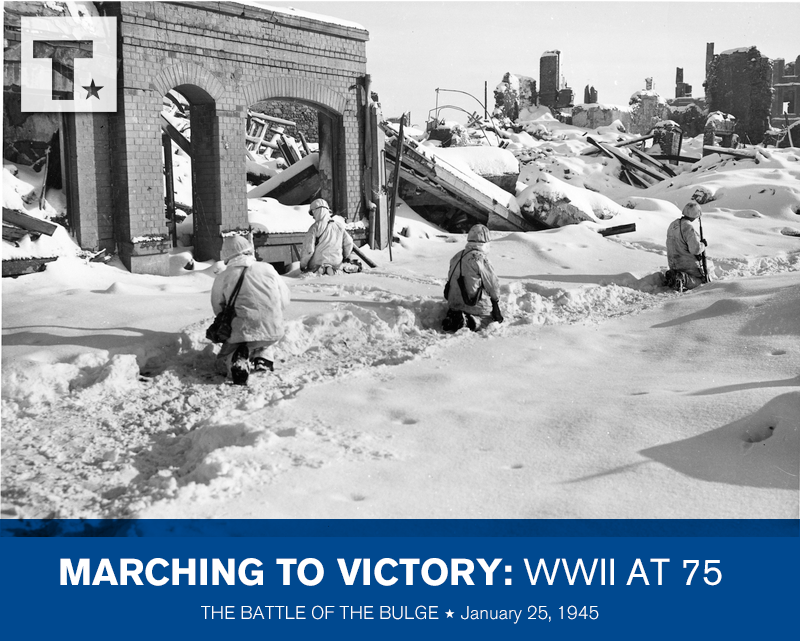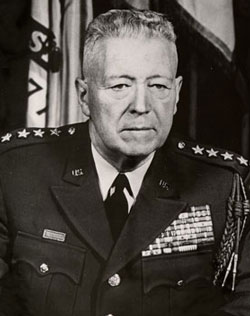WWII 75: Marching to Victory | January 25, 2020

WWII highlights from the Truman Library’s archives and collections
Marching to Victory: The Battle of the Bulge
Thursday, January 25, 1945
How did the Allied forces win the bloodiest American battle of the deadliest war in human history?
On December 16, 1944, at the beginning of a historically frigid winter, the Germans launched what would be their final major offensive of World War II. Over the course of six weeks, Allied forces thwarted the German armies’ attempts to split them. The Battle of the Bulge was the bloodiest battle for American forces on the Western Front during WWII – 20,000 Americans were killed in this battle; tens of thousands more were wounded, missing, or captured. Despite these great losses, the Battle of the Bulge ended with an Allied victory 75 years ago today.
How did the Allies win what Winston Churchill called “the greatest American battle of the war”?
General Eisenhower described General Bruce C. Clarke’s relief of the Belgium city of St. Vith as the “turning point” of the Battle of the Bulge. By slowing the German’s advance and defending a vital road junction at St. Vith, General Clarke’s leadership during the Battle of St. Vith put the Americans on a path to victory.
Bruce C. Clarke began his military service after he dropped out of high school to join the Army in 1917. A West Point Graduate, Clarke commanded the 7th and 4th Armored Divisions in General Patton’s Third Army from 1943 to 1945. He won the Silver Star three times for his valor in WWII. In 1962, Clarke retired as a four star general. During his more than 40 years of service, Clarke fought in three wars, earned the Distinguished Service Cross, three Army Distinguished service medals, three Silver Stars, the Legion of Merit, and four Bronze stars. In 1971, he attained the 33rd degree as a Mason – like President Truman.
General Clarke’s oral history is one of the approximately 500 oral histories in the Truman Library’s archives. The transcript of his 175-page oral history details everything from his view of presidents to the waging of battles. Check out this excerpt to learn more about the “turning point” of the Battle of the Bulge – the Battle of St. Vith.

CLARKE: I think the most important action I took part in was the Battle of St. Vith during the Battle of the Bulge where I found myself thrown by a stroke of fate in front of the main effort of the German army. The effort that, if successful, would have captured Liege and Namur and cut off and been behind the British army in the north. And I found myself there after the 106th Division had been overrun and practically destroyed.
I found myself there with a greatly outnumbered enemy. I held them up there for seven days during which time the American forces formed at the rear and then the main plan of the Germans had been destroyed. Marshal [Kurt von] Manteuffel gives credit to the defense that held him up there for six or seven days at St. Vith to have spoiled the German plan for the Battle of the Bulge.
It was a seven-day battle in which I had no time to lay down to go to sleep; I slept in my jeep. I used to tie myself in my seat when I traveled I sat in the seat and slept. That went on day and night for seven days. The weather was terrible, we had no air support because of the poor weather. I lost two thousand men killed in that battle in seven days. But at the end of seven days the high-water mark of the German army was reached and we, from then on, just went and finished up the war.
That was the greatest battle I ever took part in.
With the end of the Battle of the Bulge on January 25, 1945, the final victory over Nazi Germany was within reach. In less than five months, Germany would agree to an unconditional surrender.
For General Clarke’s thoughts on some of the more difficult problems he faced in the Battle of the Bulge, the importance of confidence in leading soldiers, and organizing men to fight, see his complete oral history.
PHOTO: January 24, 1945; U.S. Army soldiers of the 48th Infantry Armored Battalion in St. Vith, Belgium during the Battle of the Bulge; Harry S. Truman Library and Museum
75 years ago, World War II ended under President Truman’s decisive leadership. Now, follow key events from the war’s final months with the Truman Library Institute’s series, “Marching to Victory: WWII Highlights from the Truman Library’s Archives and Collections.” The 25-part blog series opens the vaults at Truman’s presidential library to share eyewitness accounts and historic artifacts related to major conflicts and monumental victories – from the Battle of the Bulge to the liberation of Dachau to the unconditional surrender of Japan.

Contributed by Mary McMurray, Ph.D. Her maternal grandfather, Charles G. Burns, served under General Clarke in the 7th Armored Division (the “Lucky Seventh”). His stories about history, including the battles at St. Vith and the Battle of the Bulge, helped inspire her love of history.
Join our email list to receive Truman updates right in your inbox:


